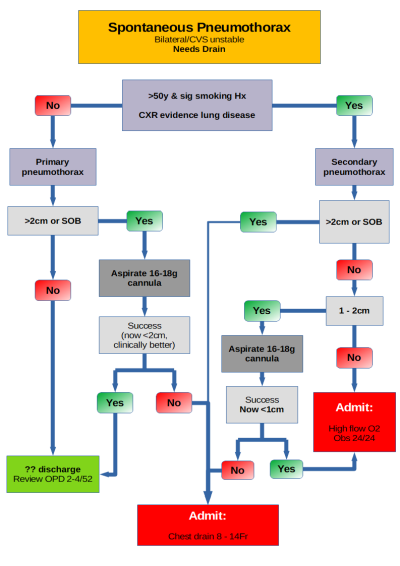Pneumothorax
ie air in the pleural cavity with consequences and management dependent on the degree of lung collapse
- spontaneous
- associated with smoking (in some studies >100x more likely), chronic lung disease eg COPD
- often taller patients
- NOT associated with exercise
- hereditary
- others - abnormal connective tissue, related to distal airway inflammation, apical ischaemia, low BMI etc
- iatrogenic
- traumatic
- catamenial
- R sided pneumothorax, generally in women 30-40y with symptoms within 48/24 of menstruation
- cause unknown but many have associated endometriosis
- one theory suggest PGF2, which is elevated in ovulation, causes bronchoconstriction which may be associated with small ruptures
Presentation
- may or may not present with pain, SOB
- examination findings of reduced air sounds, hyper-resonance on percussion rarely
- deviated trachea (with tension), subcutaneous emphysema and pneumo-mediastinum on CXR
- associated physiological signs - tachycardia, hypotension, pulsus paradoxus, ↑JVP
- clinical symptoms associated with secondary pneumothorax are generally more severe than a similar sized primary pneumothorax
- CXR should not demonstrate tension pneumothorax!! - this is a clinical finding and should have been treated before CXR!
Management
- expiratory CXR no greater accuracy than inspiratory
- size of pneumothorax generally not as important as clinical consequences, although 'large' is generally viewed as being >2cm at apex on PA CXR in UK and >3cm in USA
- methods of estimation of size are debatable. CT is better but exact estimation not necessarily important
- spontaneous resolution of primary spontaneous pneumothorax (PSP) - rate of ~2% per 24/24. Resolution 4x faster with O2 therapy and therefore reserved for IP Mx
Insertion of Intercostal Drain
- landmarks - ant to mid-axillary line, 5th ICS
- remembering that neurovascular bundle lies 'below the rib above' with vein then artery then nerve. (VAN from above down)
- 2-3cm transverse incision in line with superior border of rib, to avoid the main N/vasc bundle. (there are smaller collateral branches here though)
- blunt dissection to pleura and finger then to 'probe' canal
- using forceps clamped on end of drain, insert into space
- connect to drain bag
- suturing and dressing to ensure confident fixing of drain to chest wall
Inpatient management options
- video assisted thoracoscopic surgery with pleurectomy and abrasion
- chemical pleurodesis eg tetracycline, minocycline, doxycycline
- graded talc
- open pleurectomy
Spontaneous pneumomediatinum
References include:
BMJ Mx Pneumothorax 2010
https://handbook.ggcmedicines.org.uk/guidelines/respiratory-system/management-of-pneumothorax/
https://emedicine.medscape.com/article/424547-overview
Comparison of methods for estimating pneumothorax size. Kelly et al. 2005
https://radiopaedia.org/articles/pneumothorax?lang=gb
Europ Resp rev. Pneumothorax



